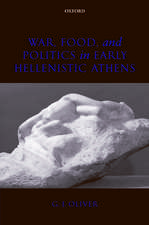The Sacred Home in Renaissance Italy
Autor Abigail Brundin, Deborah Howard, Mary Lavenen Limba Engleză Hardback – 19 iul 2018
Preț: 357.20 lei
Nou
Puncte Express: 536
Preț estimativ în valută:
68.36€ • 71.10$ • 56.43£
68.36€ • 71.10$ • 56.43£
Carte tipărită la comandă
Livrare economică 04-10 aprilie
Preluare comenzi: 021 569.72.76
Specificații
ISBN-13: 9780198816553
ISBN-10: 0198816553
Pagini: 432
Ilustrații: more than 200 black and white images
Dimensiuni: 163 x 242 x 30 mm
Greutate: 0.91 kg
Editura: OUP OXFORD
Colecția OUP Oxford
Locul publicării:Oxford, United Kingdom
ISBN-10: 0198816553
Pagini: 432
Ilustrații: more than 200 black and white images
Dimensiuni: 163 x 242 x 30 mm
Greutate: 0.91 kg
Editura: OUP OXFORD
Colecția OUP Oxford
Locul publicării:Oxford, United Kingdom
Recenzii
The Sacred Home in Renaissance Italy articulates the thesis of a "domestication" of lay devotion with panache and will surely remain an indispensable guide. It will fall to future scholarship to integrate its insights more fully with the social and institutional contexts that conditioned domestic religion. In the end, the term "Renaissance religion" may be too limited or imprecise to capture the complexities of an era of cultural conflict and political transformation.
This study is both enlightening and encouraging in its use of familiar and unfamiliar resources, and shows how to draw compelling conclusions from difficult questions.
The amount of material in the book is astonishing ... Brundin, Howard and Laven consciously seek to compensate for long-standing blind spots in Italian Renaissance scholarship. They investigate rural as well as urban areas, indigents as well as elites, local artists from foreign backgrounds, men as well as women (especially important in a book about domestic life) ... The grat power of material objects lies in their capacity to encompass multiple uses and meanings, to cross boundaries, to embrace contradictions. The book shines most when it draws these out.
This is an impressive book, the product of a substantial research project conducted by a team of scholars, and it demonstrates the value of collaborative work in fields that do not often undertake it. By combining their and their postdoctoral fellows' research expertise in Italian literature, art history, and history, and linguistic skills in several Italian dialects, they have created a wide-ranging study of domestic devotion in the Venetian terrafirma, the Marche, and Naples.
This study is both enlightening and encouraging in its use of familiar and unfamiliar resources, and shows how to draw compelling conclusions from difficult questions.
The amount of material in the book is astonishing ... Brundin, Howard and Laven consciously seek to compensate for long-standing blind spots in Italian Renaissance scholarship. They investigate rural as well as urban areas, indigents as well as elites, local artists from foreign backgrounds, men as well as women (especially important in a book about domestic life) ... The grat power of material objects lies in their capacity to encompass multiple uses and meanings, to cross boundaries, to embrace contradictions. The book shines most when it draws these out.
This is an impressive book, the product of a substantial research project conducted by a team of scholars, and it demonstrates the value of collaborative work in fields that do not often undertake it. By combining their and their postdoctoral fellows' research expertise in Italian literature, art history, and history, and linguistic skills in several Italian dialects, they have created a wide-ranging study of domestic devotion in the Venetian terrafirma, the Marche, and Naples.
Notă biografică
Abigail Brundin specializes in the literature and culture of Renaissance and Early Modern Italy. She has written on many aspects of the period, from female convents to the Grand Tour, and is above all known for her work on the poet Vittoria Colonna, as the translator of the Sonnets for Michelangelo (2005) and author of Vittoria Colonna and the Spiritual Poetics of the Italian Reformation (2008). A Fellow of St Catharine's College, she has taught at the University of Cambridge since 2002 and is currently chair of the Faculty of Modern and Medieval Languages.Deborah Howard is an architectural historian whose principal research interests revolve around the art and architecture of Venice and the Veneto, seen from an interdisciplinary perspective. Her books include Venice & the East (2000), Sound & Space in Renaissance Venice (2009, with L. Moretti) and Venice Disputed (2013). She is a Professor Emerita at the University of Cambridge, and a Fellow of St John's College. She was elected to the British Academy in 2010.Mary Laven has published widely on the social and cultural history of religion. She is the author of Virgins of Venice: Enclosed Lives and Broken Vows in the Renaissance Convent (2002) and Mission to China: Matteo Ricci and the Jesuit Encounter with the East (2011). More recently, her attention has turned to material culture and she has been involved in two major exhibition projects at the Fitzwilliam Museum. She is Professor of Early Modern History at the University of Cambridge and a Fellow of Jesus College.




















